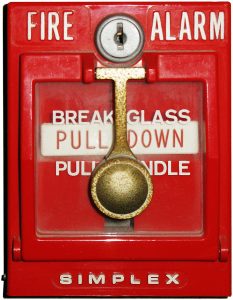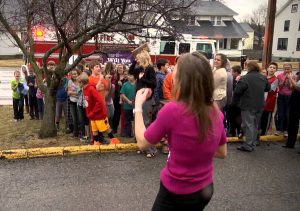 One of the most common practices of the school year is the routine fire drill. These days, children are well aware of what is going on, and often look forward to being able to vacate the classroom…even if only for a few minutes. The routine fire drill is designed to insure that the students leave the premises without panic, whether there is an actual fire or not. These drills were not always routine, the ensuing panic could be deadly.
One of the most common practices of the school year is the routine fire drill. These days, children are well aware of what is going on, and often look forward to being able to vacate the classroom…even if only for a few minutes. The routine fire drill is designed to insure that the students leave the premises without panic, whether there is an actual fire or not. These drills were not always routine, the ensuing panic could be deadly.
In 1851, in Greenwich Avenue school, located at 36 to 40 Greenwich Avenue. When the fire alarm sounded, the children panicked. They had not been trained to calmly exit the building, and in the ensuing panic, 40 children were killed. There was no fire, and the fire alarm had been set off by accident, but the children had no idea what to do, and so went running in fear. The deaths were horrible trample deaths. More children were injured.
The tragedy of 1851 was almost repeated in 1882, when a fire drill went off at Grammar School Number 41, at the same sight of the 1851 panic. The situation may have occurred on a different date, but the result was the same…panic. When the fire alarm sounded, someone cried, Fire!!” After that, chaos took over, and the same disaster could have happened, had not the teachers, janitor, firemen, and police stayed calm. Somehow they managed to calm the children down. The adults behaved with such rare intelligence and energy that the panic was stayed and nearly all the children reached the avenue unharmed. Grammar School Number 41 was an all-girl school. At the time of the panic 610 students were in the 11 classrooms of the primary school on the first floor, under Miss Susanna Whitney, and 669 were in the 19 classrooms of the grammar school on the second and third floors, under Miss Lizzie Cavannah. There was a female teacher in each of the classrooms.

Somehow, all of the 1200+ students got out alive. When the school reopened, an order was received from City Superintendent John Jasper to perfect the scholars in the fire drill. “Each scholar has a numbered peg on which to hang her clothes, and the fire drill consisted in sounding an alarm, when the scholars are required to get their clothes and collect their books and return to their seats. Meanwhile preparations were made for the teachers to be on the landings of the seven staircases, four of which are fire-proof, which lead to the four exits on Greenwich-avenue. At a signal the children were to rise and go out calmly. Going down the stairs one only was permitted to be on each side of the staircase, where there is a handrail, and the exit to the avenue was required to be in an orderly manner.”
Previously, the fire drill alarm was sounded on the tinkling class bells from bell handles in the assembly room of the primary and grammar departments. This was deemed unsafe, as it necessitated the pulling of as many handles as there were classrooms. It had to change. To make a simultaneous alarm, three large fire-gongs were installed, so that the whole school could be notified by pulling at three handles. It does not appear that the students knew of the new arrangement. Some of them had heard of the gongs, but they had not heard them strike, and they did not receive instructions about them, which would have helped immensely. It was agreed between Miss Whitney and Miss Cavannah that a fire drill should be held on a particular day. They believed that the 140 new and untrained students in the primary school and 90 new girls in the grammar school would follow the example of the trained students. At 2:40pm, Miss Cavannah had the alarm struck on the second and third floors. Six strokes were sounded on each gong. The deep, loud noise, resembling the clang of a fire engine gong, startled even the trained students, and as they whispered to each other “fire drill” in going for their clothes the untrained students misunderstood them, and believed that the school was on fire, and that the noise of the gongs was the bells of the engines summoned to the school. There was a panic immediately, and 50 fearful girls ran screaming and bareheaded from the grammar school to the street before the teachers could spring to the doorways, bar exit, and command order. The screaming and confusion overheard alarmed  the students and teachers in the primary school, but the doors were guarded before more than 25 or 30 children escaped. For several minutes the teachers had hard work to keep back the imprisoned children. The trained students were as alarmed as the new ones, and some of them wept and begged piteously as they, despite the assurances of their teachers, who all behaved bravely except for one instance, that of a new instructress, who for a time did not understand the situation. Some of the children even ran home and told their parents and neighbors that the school was on fire and the children were burning. It almost created a panic of the whole town. It quickly became clear that prior to the first drill, the students needed instruction on procedure.
the students and teachers in the primary school, but the doors were guarded before more than 25 or 30 children escaped. For several minutes the teachers had hard work to keep back the imprisoned children. The trained students were as alarmed as the new ones, and some of them wept and begged piteously as they, despite the assurances of their teachers, who all behaved bravely except for one instance, that of a new instructress, who for a time did not understand the situation. Some of the children even ran home and told their parents and neighbors that the school was on fire and the children were burning. It almost created a panic of the whole town. It quickly became clear that prior to the first drill, the students needed instruction on procedure.


Leave a Reply